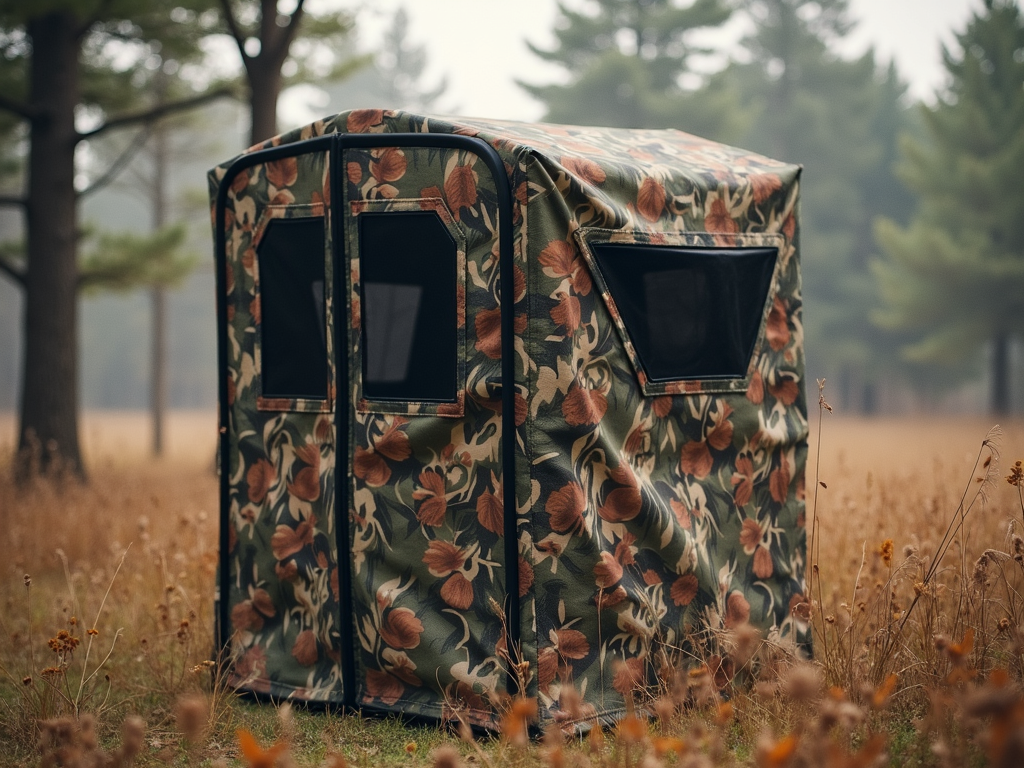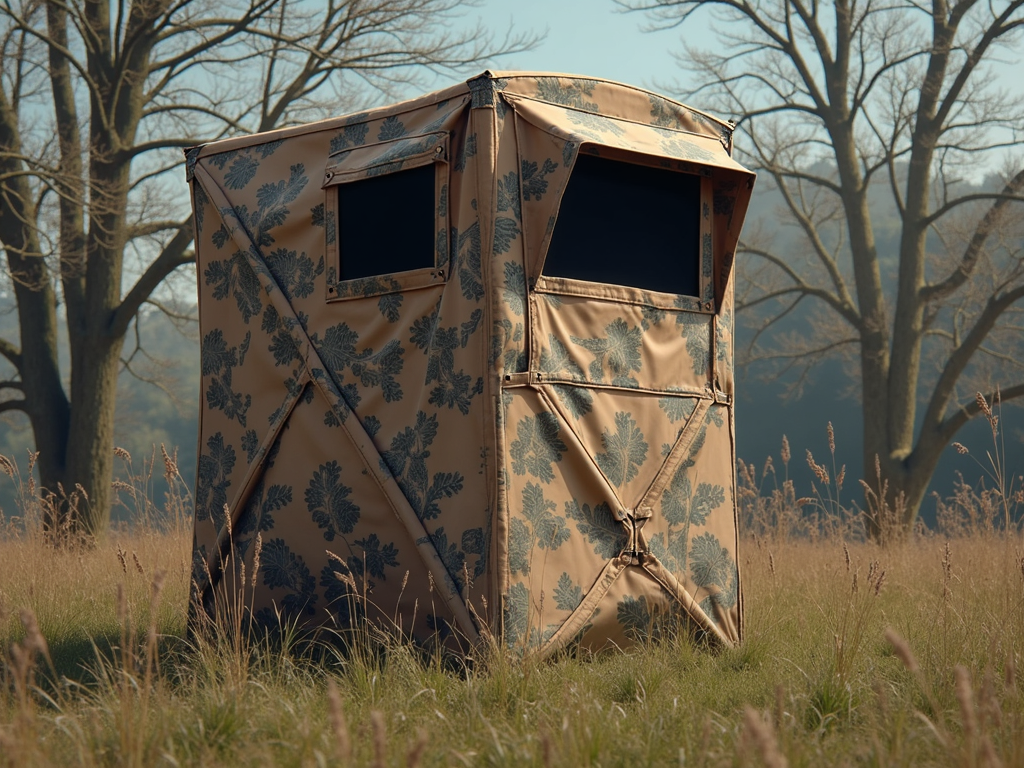Here’s a number that’ll piss you off: 73% of unsuccessful hunts happen because hunters set up in the wrong spot.
Not because their blind sucked. Not because they didn’t drop enough cash. Because they put their blind in a stupid location.

I watched a guy last season burn $800 on a Rhino Blinds fortress. Beautiful setup. Hub-style frame, shoot-through mesh, the works. Know where he put it? Middle of an open field like he was setting up a lemonade stand. Meanwhile, my buddy tagged a 10-pointer at 15 yards from a beat-up Ameristep he bought used for 80 bucks.
The difference? One guy knew where deer actually walk. The other guy knew what his credit card limit was.
Look, Bass Pro Shops and Cabela’s need you obsessed with features. Window configurations. Fabric technology. Waterproof ratings that matter about as much as the color of your underwear when you’re sitting 200 yards from the nearest deer trail.
This isn’t another gear review comparing the Double Bull Matrix against the Muddy Infinity. You can find a thousand of those written by guys who’ve never sat in either one.
This is about the thing nobody talks about. The uncomfortable truth that makes expensive blinds worthless and cheap ones deadly.
The Hidden Science of Game Movement (That Nobody Wants You to Know)
Animals don’t wander around like tourists. They move between bedding areas and food sources like you driving between home and work. Same route. Every day. Until something makes them change.
Recent GPS collar studies tracked whitetail movement for six straight months. The results should embarrass every hunter who thinks gear matters more than location. Ground blinds placed at natural transition zones saw three times more game activity than randomly placed setups.
Three times. Doesn’t matter if you’re sitting in a Barronett Pentagon or a tarp draped over sticks.
Think about that next time someone brags about their new Double Bull with panoramic windows.
What Actually Matters: Terrain Funnels
Pinch points concentrate deer like a bottleneck concentrates traffic. Could be where thick timber meets a cornfield. Where two ridges squeeze together. Where a creek forces movement along one bank.
These aren’t secrets. The terrain screams this information at you. You just have to shut up and listen.
One Wisconsin study tagged 47 bucks with GPS collars. Tracked them all season. Know what they found? 82% of those bucks used the same three transition corridors every single day. The successful bow hunters weren’t the ones with premium setups. They were the ones who found those corridors first.

Here’s the kicker – you don’t need expensive scouting cameras or decades of experience. Pull up aerial photos. Look where dark timber meets lighter fields. See those narrow strips of cover connecting two woodlots? There’s your honey hole.
Animals are lazy. Just like you. They take the easiest path that keeps them feeling safe. Your job isn’t picking the best bow hunting blinds. It’s finding where that path goes.
I’ve killed more deer from a $60 Primos Smokescreen in the right spot than most hunters see from their climate-controlled tower blinds in the wrong spot. Location beats equipment. Every. Single. Time.
The See-Through Blind Revolution (That’s Mostly BS)
Everyone’s losing their minds over see-through hunting blinds. “Revolutionary visibility!” “Total concealment with 360-degree views!”
Yeah, okay. Let me tell you about revolutionary stupidity.
Hunter in Michigan last season. Brand new Barronett Big Mike with their fancy see-through panels. Sets it up 20 yards from a massive scrape. Perfect distance for archery. But this genius faces the door east because “that’s where the deer sign was.”
By 10 AM, sun’s cooking through that mesh like a greenhouse. Can’t see jack. Meanwhile, every deer in the county is moving through the shadows behind him where they actually feel safe. He sat there all day watching nothing while getting a sunburn through “revolutionary” fabric.
Same blind. Same exact spot. Different hunter the next week.
This guy has a functioning brain. Sets up facing north, keeps the sun at his back all day. Uses those see-through panels to watch his flanks while his main shooting lanes stay in shadow. Dropped a 140-class buck at 11:30 AM while half the “serious” hunters were already back at camp complaining about not seeing anything.
The Truth About View-Through Technology
These fabrics aren’t magic. The Rhino 180, Alps OutdoorZ Dash Panel, all work on basic physics. One-way visibility needs darker inside, lighter outside. Mess up your sun angles? You just bought the world’s most expensive tanning booth.
But here’s what actually matters more than any space-age fabric – wind direction. Realtree could invent a pattern that makes you literally invisible. Won’t matter if your scent’s broadcasting “HUMAN DANGER” downwind at every deer within 400 yards.
Those see-through panels? Their real value isn’t gawking at squirrels. It’s watching vegetation movement to monitor wind shifts. Set your blind so prevailing winds blow from where deer approach toward your back or side. Use the panels to confirm wind hasn’t betrayed you. Basic stuff that beats technology every time.
Environmental Integration: Why Your Expensive Blind Looks Like an Alien Spacecraft
Here’s what Bowhunter Magazine won’t tell you – lightweight pop up hunting blinds that get properly brushed in consistently outperform heavy “permanent” hub style hunting blinds that look like someone parked a tank in the woods.
Why? Because deer aren’t stupid.
Drop a big geometric shape in their living room, they’ll avoid it like it’s radioactive. But gradually integrate something that matches the surroundings? They’ll walk past it like it’s another bush.
Take the Muddy Outdoors Boss – solid blind, good reviews. I’ve watched hunters ruin it by setting up naked. No brush. No integration. Just a massive olive cube screaming “I DON’T BELONG HERE.”
Meanwhile, some kid with a ratty Ameristep Doghouse throws local branches on it, lets it sit for three days, and it vanishes. Becomes part of the landscape. Guess who fills tags?
The 72-Hour Rule Nobody Talks About
Scent control sprays are mostly theater. You know what actually works? Time.
Set up your ground blind when you’re sweaty from hauling gear. Then don’t hunt it for 72 hours. Let rain wash it. Wind air it out. Let the woods accept it as part of the furniture. This matters more than any camouflage pattern Mossy Oak ever designed.
Ground prep beats camo every time. Clear shooting lanes but keep cover between you and where deer approach. They need to feel safe right until the moment they aren’t. Give them that security or they’ll bounce before reaching bow range.
And here’s the dirty secret – weathered, ugly blinds that animals are used to seeing work infinitely better than fresh-out-of-the-box setups. That’s why my 5-year-old sun-faded Primos consistently outperforms shiny new premium blinds.
Blind Placement Intelligence: The System That Actually Works
Forget comparing portable hunting blinds. Let’s talk about the system that makes any blind deadly.
Step 1: Find the X
Terrain funnels exist everywhere. That spot where the woods narrow between two fields? Where the creek bend forces movement to one side? Where thick bedding cover meets food but only through one safe corridor? That’s your spot. Not where you saw a rub last year. Where the land forces movement TODAY.
Step 2: Set According to Sun and Wind
Morning setups face north or west. Afternoon setups face north or east. Always. Sun behind or beside you, never in your face. Position so prevailing winds blow from anticipated deer approach toward your back or side. Screw this up and no amount of scent eliminator saves you.
Step 3: Integration Over Isolation
Use existing structure. Set against deadfalls, fence rows, brush piles. Your blind becomes part of something already there instead of an obvious addition. Cut local vegetation – from RIGHT THERE, not 50 yards away. Attach it naturally. Messy is good. Nature isn’t neat.
Step 4: Time Investment
Set up minimum 72 hours before hunting. Longer is better. A blind that’s been there two weeks beats one that showed up yesterday, regardless of price tag. Let weather and time do what no camo pattern can – make it belong.
Your Choice: Keep Buying or Start Thinking
Here’s your reality check – that $500 Double Bull sitting in a terrible spot is just an expensive photography blind. That $80 used Ameristep in a terrain funnel is a killing machine.
The hunting industry needs you focused on hub versus pop-up. Window heights. Waterproof ratings. Burrito doors versus full-front access. It’s all noise designed to separate you from your money.
Success comes from understanding where animals want to be and putting literally any blind there first. Find where terrain creates opportunity. Position based on sun and wind, not just concealment. Integrate with time and local materials.
Do these things right? I guarantee you’ll see more game from budget hunting blinds than most hunters see from their premium setups.
Stop reading reviews comparing the best hunting blinds for beginners. Start studying topo maps of your hunting area. Stop shopping for hunting blind accessories. Start walking ridges looking for pinch points.
This weekend? Leave the catalogs alone. Put on your boots. Find one transition zone. One funnel. One spot where the land itself stacks odds in your favor.
Because the best bow hunting blind is the one sitting where deer actually walk. Everything else is just expensive furniture in the woods.
Next time someone brags about their high-dollar blind, ask them one question: “Where’d you put it?”
Watch them stutter. Then go fill your freezer from a clearance-rack special in the right spot.
That’s the difference between shoppers and hunters.